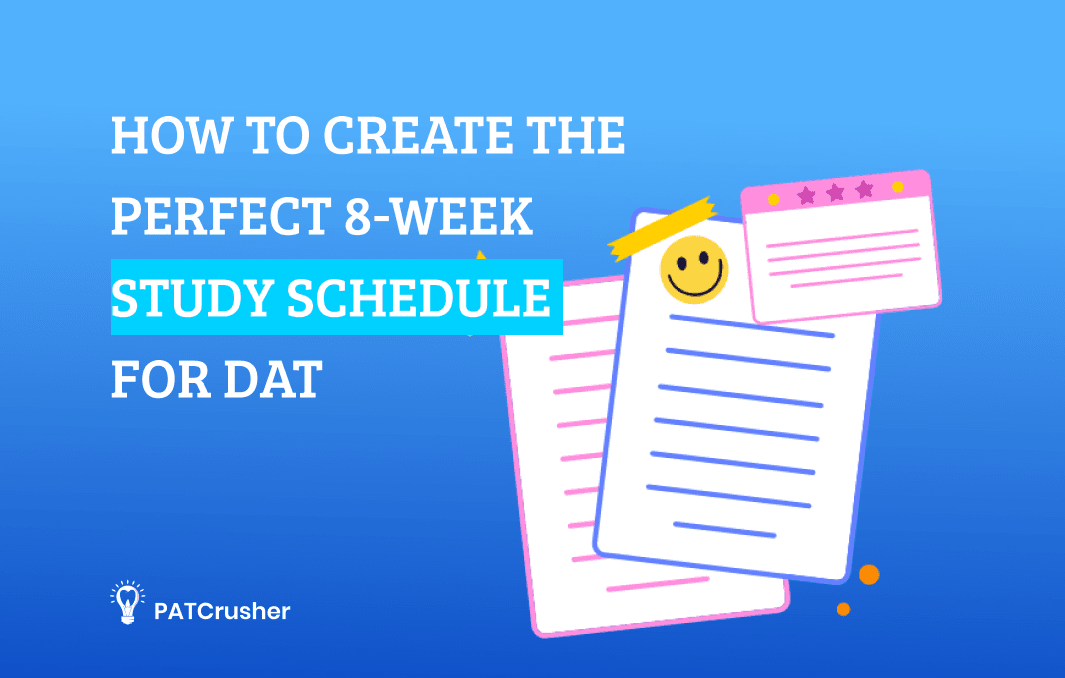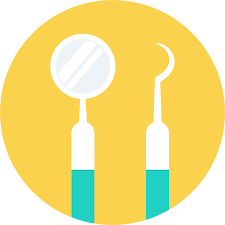sDental Admission Test or DAT can be quite a stress. But with dedication and perseverance, it is not impossible to ace the test. On top of that, if you have a perfect study schedule, there’s no way you will not ace in DAT.

Cramped schedules have nothing to offer except for making you stressed and sleep-deprived. A simple and comprehensive study planner is all you need to prepare yourself fully to face the DAT.
Different students have different weak and strong suits. Hence, one routine will not work the same for everyone. Therefore, we aim to provide you with a basic and well-balanced schedule.
No matter what background you are from, this planner should suffice all your needs. If it doesn’t, do not hesitate to accommodate your needs and materials into the schedule.
TL;DR
- A perfect study planner is a must-have to prepare yourself for the DAT.
- Your study planner should focus on your weaknesses rather than the number of study materials.
- The time frame for DAT preparation depends upon a student’s learning mechanism and habits.
- Two months are sufficient if you have the right study schedule along with a perfect DAT prep tool.
Are 8 Weeks Enough for DAT Preparation?
Firstly, two months are sufficient to prepare yourself for the DAT. However, this might not work for every individual because every student has their own needs.
The timeframe you should set for preparing for DAT depends on how much time you can handle every study session.
Some students can effortlessly master any topic within 1 hour, and then some students will need 3-4 hours to grasp that topic. Some might require more than that.
Moreover, if a student with a fast reading pace forgets what they read, then they must start revising a few weeks or days before the test. So, during exams, the concepts are fresh in your mind.
On the other hand, a student with a sharp memory can start reading six months before the exam.
This is why the study schedule depends on the type of learner a student is. Moreover, the timeframe for DAT prep depends on how good you are at mastering topics.
If you want to go slowly, you should start DAT preparation six months before the exam. If you choose to study only two months before the exam, be ready for long study sessions.
Because you will also compete with the students who have studied 4-6 hours every day for a long time, hence, to compensate for that, you have to study more in your shorter timeframe.
You can surely prepare for DAT in two months and even nail it down. But it is not going to be easy.
The point is, the less timeframe you choose to prepare yourself, the more smartly you will have to prepare yourself.
How to Prepare Yourself for the DAT?
Before we present a routine, we would like to offer you some insights into preparing yourself for the DAT. You can always change the routine according to your needs. But some certain points will help you to achieve your goal.
Treat the preparatory phase like a full-time job
The study hours should be 40 hours per week. You can alter your daily schedule making sure you are reaching this 40-hour goal.
There will be lazy days when you will not feel like studying. Then again, there will be days when you will want to put in extra hours. Whatever it is, do not overdo or underdo it.
Multiple day-offs are the ultimate killers for your preparation. Keep a regular study habit. Try to follow the schedule closely. The plan will only be helpful if you are following it as much as you can.
Do not pile up your reading table with tons of studying materials
This is a common mistake most pre-dental make- piling up their table with many studying materials.
There is a common misconception among pre-dental that more study materials increase getting into a DAT school.
But the truth is, you need reliable study materials.
The quality of your study material is more important than the number of study materials you have. There are dozens of options on the internet. Do your research and pick up the right one. For example, you can choose PATCrusher. PATCrusher has helped 14000 students to crush the PAT section of the DAT.
With its unlimited questions along with detailed explanations, there’s no way you will go wrong.
Do not put all your efforts into one topic at once
While focusing on a single topic with a lot of effort is not a bad idea, it is not a smart idea either. Studying one subject for a long time can be tedious. Moreover, it prevents you from studying other topics. Consequently, you may forget those subjects.
It is necessary to put more effort into your weaknesses. But let’s not forget that DAT consists of different parts. Hence, you have to master all those along with turning your weak zones into strong ones.
One of the efficient tricks is to practice the actual test questions daily. Not only will you comprehend the DAT question, but it will also help you to skim through all subjects at once.
Your DAT study schedule must include practice tests and quizzes. The more practice tests you go through, the more prepared you are for these tests.
Because the answers you got wrong helps you to understand your failings and take action accordingly. If your study sessions cover half of your DAT Prep, the other half comes from the mistakes you make during mock tests.
You can choose PATCrusher to help you with this. The app will let you practice on the go. You will get a detailed score as well that will help you to analyze your preparation technique better.
Stay fit and healthy.
Long study sessions require you to sit on your chair for a long time. You might develop back pain, neck aches due to this.
Therefore, you should do some yoga and stretching exercises daily to keep yourself fit.
As much as studying is important to ace the DAT, being fit and healthy is also important. All your efforts will be futile if you fall sick right before the exam.
Components of The DAT
You will notice that PAT, reading comprehension, and quantitative reasoning occupy low study hours in our routine. That’s because they are not demanding study hours compared to the other subjects.
For instance, when it comes to PAT or the Perceptual Ability Test, you need experience solving the problems.
PATCrusher is a great tool for that. It ensures higher scores for all its users. If you go to the review section of our website, you will notice several students confidently recommending it.
Reading comprehension test depends upon the experience with reading material. Look out for some scientific articles and try to understand and analyze them. Mastering quantitative reasoning depends on your practice.
8-Week DAT Study Schedule
Here’s our 8-week study schedule that can help you crush the DAT.
Week 1

Week 2

Week 3

Week 4

Week 5

Week 6

Week 7

Week 8

The DAT preparation schedule presented above is basic. If you follow it thoroughly, you will surely crack the DAT with a significant score.
The schedule does not focus on weak points or the number of study materials a student might have. Hence you can alter it on your own.
You get Sundays to chill out. After such a stressful and tedious schedule throughout the week, you should take a day off and socialize a bit.
This is the number of hours per subject depending on the schedule-
- Biology – 88 hours
- General chemistry – 88 hours
- Perceptual Ability Test/ PAT – 78 hours
- Quantitative Reasoning Test – 22 hours
- Practice Test – 24 hours
DAT Study Schedule FAQ
How many times can you take the DAT?
You can sit for the DAT as many times as you want to attain a desirable score.
But if you exceed three times, you have to forward ADA a school-going proof or any dental progress-related evidence to take the test.
How long does it take for DAT scores to publish?
You will receive non-official preliminary results immediately after your DAT. But the score might change after standardization.
Hence you will be able to access the official results within a month of sitting for DAT.
Wrapping Up
Let no one lie to you- DAT isn’t easy. Nonetheless, it is not rocket science as well.
People have cracked the DAT before. Hence, don’t bother to worry that you will not be one of them. The 2-month study schedule presented in this article, combined with hard work is enough for you to ace the DAT.
Shine bright with persistence and dedication. Make your dream come true.
An efficient DAT study tool like PATCrusher will help you in this journey. Sign up for free today and make yourself prepared for the DAT battle.













![DAT PAT Pattern Folding Strategy Guide for 2022 [Updated] 23 DAT PAT Pattern Folding Strategy Guide for 2020 [Updated]](https://patcrusher.com/wp-content/uploads/2020/01/pattern_580436a7e1e999b2d9b1540fd198bd82_2000.png)
![DAT PAT Pattern Folding Strategy Guide for 2022 [Updated] 24 Pattern folding](https://images.storychief.com/account_2446/pattern_580436a7e1e999b2d9b1540fd198bd82_800.png)













![DAT Cube Counting - A Guided Introduction 2022 [Updated] 38 PAT Cube Counting - A Guided Introduction 2020 [Updated]](https://patcrusher.com/wp-content/uploads/2020/01/ScreenShot2020-01-07at3_32_20PM_7feb610c38a373d3d387974dde59e1de_2000.png)
![DAT Cube Counting - A Guided Introduction 2022 [Updated] 39 cube counting](https://images.storychief.com/account_2446/ScreenShot2020-01-07at3_32_20PM_7feb610c38a373d3d387974dde59e1de_800.png)
![DAT Hole Punching: PAT Guide for 2022 [Updated] 40 DAT Hole Punching: PAT Guide for 2020 [Updated]](https://patcrusher.com/wp-content/uploads/2020/01/hole_f1fdcbc5f18c600640f9af6a582134c0_2000.png)
![DAT Hole Punching: PAT Guide for 2022 [Updated] 41 hole punching](https://images.storychief.com/account_2446/hole_f1fdcbc5f18c600640f9af6a582134c0_800.png)